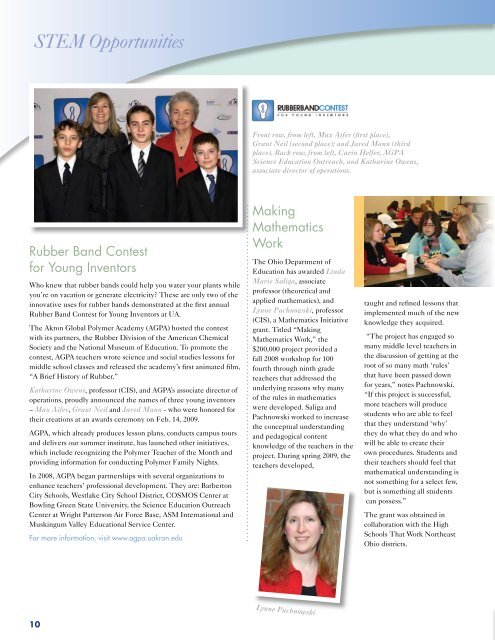Building Our Future - The University of Akron
Building Our Future - The University of Akron
Building Our Future - The University of Akron
Create successful ePaper yourself
Turn your PDF publications into a flip-book with our unique Google optimized e-Paper software.
STEM Opportunities<br />
Front row, from left, Max Aifer (first place),<br />
Grant Neil (second place); and Jared Mann (third<br />
place). Back row, from left, Carin Helfer, AGPA<br />
Science Education Outreach, and Katharine Owens,<br />
associate director <strong>of</strong> operations.<br />
Rubber Band Contest<br />
for Young Inventors<br />
Who knew that rubber bands could help you water your plants while<br />
you’re on vacation or generate electricity? <strong>The</strong>se are only two <strong>of</strong> the<br />
innovative uses for rubber bands demonstrated at the first annual<br />
Rubber Band Contest for Young Inventors at UA.<br />
<strong>The</strong> <strong>Akron</strong> Global Polymer Academy (AGPA) hosted the contest<br />
with its partners, the Rubber Division <strong>of</strong> the American Chemical<br />
Society and the National Museum <strong>of</strong> Education. To promote the<br />
contest, AGPA teachers wrote science and social studies lessons for<br />
middle school classes and released the academy’s first animated film,<br />
“A Brief History <strong>of</strong> Rubber.”<br />
Katharine Owens, pr<strong>of</strong>essor (CIS), and AGPA’s associate director <strong>of</strong><br />
operations, proudly announced the names <strong>of</strong> three young inventors<br />
– Max Aifer, Grant Neil and Jared Mann - who were honored for<br />
their creations at an awards ceremony on Feb. 14, 2009.<br />
AGPA, which already produces lesson plans, conducts campus tours<br />
and delivers our summer institute, has launched other initiatives,<br />
which include recognizing the Polymer Teacher <strong>of</strong> the Month and<br />
providing information for conducting Polymer Family Nights.<br />
In 2008, AGPA began partnerships with several organizations to<br />
enhance teachers’ pr<strong>of</strong>essional development. <strong>The</strong>y are: Barberton<br />
City Schools, Westlake City School District, COSMOS Center at<br />
Bowling Green State <strong>University</strong>, the Science Education Outreach<br />
Center at Wright Patterson Air Force Base, ASM International and<br />
Muskingum Valley Educational Service Center.<br />
For more information, visit www.agpa.uakron.edu<br />
Making<br />
Mathematics<br />
Work<br />
<strong>The</strong> Ohio Department <strong>of</strong><br />
Education has awarded Linda<br />
Marie Saliga, associate<br />
pr<strong>of</strong>essor (theoretical and<br />
applied mathematics), and<br />
Lynne Pachnowski, pr<strong>of</strong>essor<br />
(CIS), a Mathematics Initiative<br />
grant. Titled “Making<br />
Mathematics Work,” the<br />
$200,000 project provided a<br />
fall 2008 workshop for 100<br />
fourth through ninth grade<br />
teachers that addressed the<br />
underlying reasons why many<br />
<strong>of</strong> the rules in mathematics<br />
were developed. Saliga and<br />
Pachnowski worked to increase<br />
the conceptual understanding<br />
and pedagogical content<br />
knowledge <strong>of</strong> the teachers in the<br />
project. During spring 2009, the<br />
teachers developed,<br />
taught and refined lessons that<br />
implemented much <strong>of</strong> the new<br />
knowledge they acquired.<br />
“<strong>The</strong> project has engaged so<br />
many middle level teachers in<br />
the discussion <strong>of</strong> getting at the<br />
root <strong>of</strong> so many math ‘rules’<br />
that have been passed down<br />
for years,” notes Pachnowski.<br />
“If this project is successful,<br />
more teachers will produce<br />
students who are able to feel<br />
that they understand ‘why’<br />
they do what they do and who<br />
will be able to create their<br />
own procedures. Students and<br />
their teachers should feel that<br />
mathematical understanding is<br />
not something for a select few,<br />
but is something all students<br />
can possess.”<br />
<strong>The</strong> grant was obtained in<br />
collaboration with the High<br />
Schools That Work Northeast<br />
Ohio districts.<br />
Lynne Pachnowski<br />
10
















